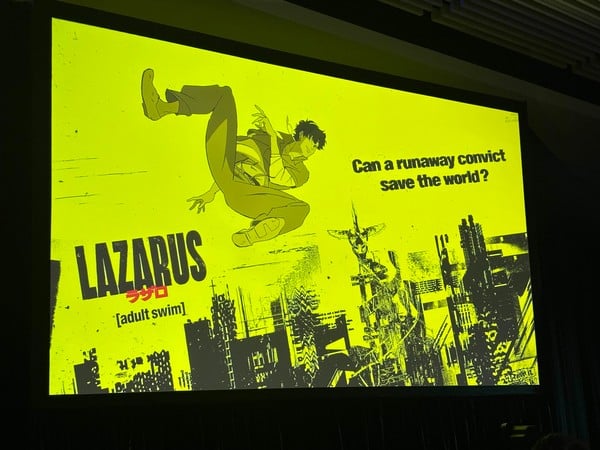The anime world has always been a space for innovation, daring storytelling, and unforgettable characters. When it comes to directors who exemplify these qualities, Shinichiro Watanabe stands at the pinnacle. Known for his genre-defining works like “Cowboy Bebop” and “Samurai Champloo”, Watanabe has earned a reputation for blending action, music, and existential musings into unforgettable anime experiences. Thus, when Watanabe announces a new project, the anime community collectively braces for something significant. His upcoming anime “Lazarus”, a 13-episode action sci-fi series, has been no exception, with early buzz framing it as potentially his next great masterpiece. Anime News Network’s attendance at a preview of the first episode adds fuel to this hype, as Watanabe himself claims this series to be a work that will contribute to his legacy, even calling it his “masterpiece.”
From the first episode, “Lazarus” immediately immerses viewers in a dystopian future where scientific progress has both enhanced and imperiled humanity. A perfect drug has been developed—something seemingly miraculous, with no side effects. The premise itself is evocative of the broader cultural anxiety surrounding pharmaceuticals and scientific experimentation. What happens when humans become reliant on something they do not fully understand? “Lazarus” offers a chilling answer: in this world, a mysterious video emerges announcing that everyone who has taken this wonder drug will die in thirty days, and there is no known way to prevent the disaster unless the man behind the drug, a scientist who has since vanished, is found.
The first episode wastes no time in building tension, setting a timer on humanity’s survival from the outset. Watanabe establishes the stakes with an urgency that will no doubt fuel the momentum of the remaining twelve episodes. This countdown device, reminiscent of classic thriller and action films, adds an omnipresent sense of dread that grounds the show’s larger-than-life action sequences. In “Lazarus”, the clock is always ticking, and survival depends on solving the enigma at the center of this world.
The concept of a perfect drug, and its sinister turn, is not new in science fiction. We’ve seen similar ideas explored in works like “Limitless”, where a miraculous pill grants heightened cognitive abilities, and “Brave New World”, where drugs are used to keep the population in a state of happiness and complacency. However, Watanabe’s take on this concept in “Lazarus”feels fresh because of the specificity of its social and emotional stakes. The drug was once seen as a gift to humanity, something that had the potential to eradicate the pain and suffering associated with other pharmaceuticals’ side effects. But this scientific advancement also becomes humanity’s doom, and the show explores the consequences of humans embracing a solution without understanding its long-term effects.
This theme resonates in today’s world, where our relationship with technology and medicine is often characterized by blind faith in progress. Pharmaceuticals, especially those rapidly developed or hastily approved, are increasingly under scrutiny, with debates raging around safety, efficacy, and long-term consequences. By drawing from these real-world anxieties, “Lazarus” taps into a vein of socio-political relevance that gives the show an added depth. It’s not just about action or adventure; it’s a reflection on how our collective trust in science and technology can sometimes lead us toward unanticipated disaster.
In “Lazarus”, the protagonist Axel Gilbert is introduced as a rebellious figure, imprisoned yet constantly escaping from his confines through the use of parkour and an incredible mastery of physical agility. This focus on parkour feels like a direct callback to Watanabe’s love of kinetic action sequences and fluid motion. Much like Samurai Champloo’s breakdance-inspired sword fighting or Cowboy Bebop’s martial arts sequences, Axel’s parkour abilities aren’t just a stylistic choice—they are an extension of his character.
Axel’s ability to escape repeatedly from prison with his dexterity and quick thinking underscores his role as an independent and resourceful hero. His physicality reflects his mentality: he’s not someone who’s easily confined or controlled, always thinking one step ahead of his captors. Throughout the first episode, Axel is constantly on the run, using his environment to his advantage as he evades various colorful characters who try to capture him. These sequences showcase Watanabe’s talent for creating action that feels both choreographed and spontaneous. Each of Axel’s movements, whether a leap across a rooftop or a quick sprint along a narrow ledge, is precise yet feels entirely instinctual, giving the character a visceral sense of freedom even as he is being hunted.
However, Axel’s parkour is more than just a physical manifestation of his character. It serves as a metaphor for his deeper role in the story. Parkour, by its nature, is about navigating obstacles in an unconventional way. Axel’s journey, then, mirrors his movement; he is not someone who will follow the traditional paths or obey societal rules. Instead, he will carve his own way, using creativity and agility to survive in a world that is closing in on him. This is fitting, as his survival—along with humanity’s—depends on his ability to stay ahead of the clock and unravel the mystery of the drug and its creator.
The first episode of “Lazarus” introduces a variety of characters who pursue Axel with unique skills of their own. These characters, while still mysterious, hint at the diversity of talents and personalities that will populate the series. Watanabe’s ability to create a colorful ensemble is on full display here. From the moment we see Axel in jail, it becomes clear that the people hunting him are no mere grunts. Their various methods of cornering Axel reflect the diverse threats he will face throughout the show.
The fact that Axel is eventually captured, only to wake up in a barbershop surrounded by those who pursued him, suggests that these characters are more than just enemies or obstacles. They are part of a larger, interconnected group—Lazarus—rallied together by a mysterious woman who visited Axel in prison. This group’s existence raises interesting questions about their motivations and the wider stakes of the series. Who is the woman leading them, and why does she see Axel as a key to solving the problem of the drug? The mystery of their involvement adds another layer to the show, pushing it beyond a simple chase narrative and into something more intricate and character-driven.
Watanabe has always excelled at creating ensembles, and “Lazarus” seems poised to be no different. Just as Cowboy Bebop’s crew of misfits became iconic for their distinct personalities and complex relationships, “Lazarus” appears to be setting the stage for a similarly dynamic cast. This ensemble will likely serve as both allies and antagonists to Axel, as each character seems to have their own agenda, all tied to the central mystery of the drug’s impending doom.
Impression
“Lazarus” fits neatly within the action-sci-fi genre, and from the first episode, Watanabe’s influences are clear. The show’s premise—a race against time to prevent a scientific disaster—evokes classic sci-fi narratives, particularly those that deal with the consequences of unchecked technological advancement. Films like “Blade Runner” and “Akira” come to mind, where the consequences of human innovation become existential threats. However, Watanabe infuses his signature style into the mix, blending the action-heavy sequences with philosophical undertones.
In “Cowboy Bebop”, Watanabe often used his episodic format to explore broader existential themes, such as the nature of identity, fate, and the search for meaning. “Lazarus” seems to be heading in a similar direction, using its sci-fi setting to probe questions about mortality, trust in scientific authority, and the fragility of human life. The show’s central question—how do you live knowing you might die in thirty days?—is one that promises to delve into the characters’ emotional and psychological states. This existential dread, combined with the high-octane action scenes, is likely to give “Lazarus” a unique blend of intensity and introspection.
The countdown to humanity’s extinction is a familiar trope in both film and television, but Watanabe employs it with fresh urgency in “Lazarus”. By the end of the first episode, we learn that there are only twenty-nine days left before the drug begins to claim its victims. This countdown serves as a constant reminder of the stakes at play, adding pressure to every decision and action the characters take. It also raises intriguing questions about how the series will pace itself. With each episode representing roughly two or three days in the show’s timeline, the countdown structure could give “Lazarus” a tight, focused narrative arc that accelerates as the clock ticks down.
The countdown also introduces a moral dimension to the story. If there is only a month left to live, how do the characters cope with this knowledge? Will they become more desperate as time runs out, or will they cling to hope and fight to the bitter end? The ticking clock adds psychological tension to the physical action, pushing the characters to their limits as they navigate both external threats and internal conflicts.
The first episode of “Lazarus” sets the stage for what promises to be an intense, high-stakes journey. Watanabe’s talent for blending action, philosophy, and complex character dynamics is on full display, and the show’s premise—a race against time to stop a scientific disaster—offers fertile ground for both thrilling set pieces and deeper existential musings. As the clock ticks down and Axel Gilbert navigates the dangers ahead, “Lazarus” appears poised to become a defining work in Watanabe’s storied career. If this first episode is any indication, “Lazarus” has all the makings of a modern anime masterpiece, one that could very well cement Watanabe’s legacy as a visionary storyteller.
No comments yet.







